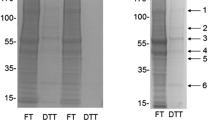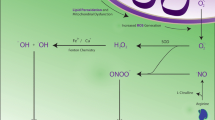Abstract
Reversible oxidations of protein thiols have emerged as alternatives to free radical-mediated oxidative damage with which to consider the impacts of oxidative stress on cellular activities but the scope and pathways of such oxidations in tissues, including the brain, have yet to be fully defined. We report here a characterization of reversible oxidations of glutathione and protein thiols in extracts from rat brains, from two sources, which had been (1) frozen quickly after euthanasia to preserve in vivo redox states and (2) subjected to alkylation upon tissue disruption to trap reduced thiols. Brains were defined, relatively, as Reduced and Moderately Oxidized based on measured ratios of reduced (GSH) to oxidized (GSSG) glutathione. Levels of protein disulfides formed by the cross-linking of closely-spaced (vicinal) protein thiols, but not protein S-glutathionylation, were higher in extracts from the Moderately Oxidized brains compared to the Reduced brains. Moreover, the oxidized vicinal thiol proteome contains proteins that impact cellular energetics, signaling, neurotransmission, and cytoskeletal dynamics among others. These findings argue that kinetically-competent pathways for reversible, two-electron oxidations, of protein vicinal thiols can be activated in healthy brains in response to physiological oxidative stresses. We propose that such oxidations may link oxidative stress to adaptive, but also potentially deleterious, changes in neural cell activities in otherwise healthy brains.



Similar content being viewed by others
References
Markesbery WR (1997) Oxidative stress hypothesis in Alzheimer’s disease. Free Rad Biol Med 23:134–147
Wouters MA, Lismaa S, Fan SW, Haworth NL (2011) Thiol-based redox signaling: rust never sleeps. Int J Biochem Cell Biol 43:1079–1085
Cremers CM, Jakob U (2013) Oxidant sensing by reversible disulfide bond formation. J Biol Chem 288:26489–26496
Cumming RC, Andon NL, Haynes PA, Park M, Fischer WH, Schubert D (2004) Protein disulfide bond formation in the cytoplasm during oxidative stress. J Biol Chem 279:21749–21758
Brennan JP, Wait R, Begum S, Bell JR, Dunn MJ, Eaton P (2004) Detection and mapping of widespread intermolecular protein disulfide formation during cardiac oxidative stress using proteomics with diagonal electrophoresis. J Biol Chem 279:41352–41360
Randall LM, Ferrer-Sueta G, Denicola A (2013) Peroxiredoxins as preferential targets in H2O2-induced signaling. Methods Enzymol 527:41–63
Giustarini D, Dalle-Donne I, Mizani A, Fanti P, Rossi R (2013) Analysis of GSH and GSSG after derivatization with N-ethylmaleimide. Nat Protoc 8:1660–1669
Beer SM, Taylor ER, Brown SE, Dahm CC, Costa NJ, Runswick MJ, Murphy MP (2004) Glutaredoxin 2 catalyzes the reversible oxidation and glutathionylation of mitochondrial membrane thiol proteins. J Biol Chem 279:47939–47951
Foley TD, Stredny CM, Coppa TM, Gubbiotti MA (2010) An improved phenylarsine oxide-affinity method identifies triose phosphate isomerase as a candidate redox receptor protein. Neurochem Res 35:306–314
Foley TD, Melideo SL, Healey AE, Lucas EJ, Koval JA (2011) Phenylarsine oxide binding reveals redox-active and potential regulatory vicinal thiols on the catalytic subunit of protein phosphatase 2A. Neurochem Res 236:232–240
Foley TD, Clark AR, Stredny ES, Wierbowski BM (2012) SNAP-25 contains non-acylated thiol pairs that can form intrachain disulfide bonds: Possible sites for redox modulation of neurotransmission. Cell Mol Neurobiol 32:201–208
Li Y, Chi H, Wang LH, Wang HP, Fu Y, Yuan ZF, Li SJ, Liu YS, Sun RX, Zeng R, He SM (2010) Speeding up tandem mass spectrometry based database searching by peptide and spectrum indexing. Rapid Commun Mass Spectrom 24:807–814
Bjornson RD, Carriero NJ, Colangelo C, Shifman M, Cheung KH, Miller PL, Williams K (2008) X!Tandem, an improved method for running X!tandem in parallel on collections of commodity computers. J Proteome Res 7:293–299
MacLean B, Eng JK, Beavis RC, McIntosh M (2006) General framework for developing and evaluating database scoring algorithms using the TANDEM search engine. Bioinformatics 22:2830–2832
Geer LY, Markey SP, Kowalak JA, Wagner L, Xu M, Maynard DM, Yang X, Shi W, Bryant SH (2004) Open mass spectrometry search algorithm. J Proteome Res 3:958–964
Adams E, Jeter D, Cordes AW, Kolis JW (1990) Chemistry of organometalloid complexes with potential antidotes: structure of an organoarsenic(III) dithiolate ring. Inorg Chem 248:1500–1503
Hoffman RD, Lane MD (1992) Iodophenylarsine oxide and arsenical affinity chromatography: New probes for dithiol proteins. J Biol Chem 267:14005–14011
Folbergrova J, Rehncrona S, Siesjo BK (1979) Oxidized and reduced glutathione in the rat brain under normoxic and hypoxic conditions. J Neurochem 32:1621–1627
Rebrin I, Sohal RS (2004) Comparison of thiol redox state of mitochondria and homogenates of various tissues between two strains of mice with different longevities. Exp Gerontol 39:1513–1519
Rebrin I, Forster MJ, Sohal RS (2007) Effects of age and caloric restriction on glutathione redox state in different brain regions of C57BL/6 and DBA/2 mice. Brain Res 1127:10–18
Beaver LM, Klichko VI, Chow ES, Kotwica-Rolinska J, Williamson M, Orr WC, Radyuk SN, Giebultowicz JM (2012) Circadian regulation of glutathione levels and biosynthesis in Drosophila melanogaster. PLoS ONE 7:e50454
Caccamo A, Medina DX, Oddo S (2013) Glucocorticoids exacerbate cognitive deficits in TDP-25 transgenic mice via a glutathione-mediated mechanisms: implications for aging stress and TDP-43 proteinopathies. J Neurosci 33:906–913
Bencsath FA, Shartava A, Monteiro CA, Goodman SR (1996) Identification of the disulfide-linked peptide in irreversibly sickled cell beta-actin. Biochemistry 35:4403–4408
Chaudhuri AR, Khan IA, Ludueña RF (2001) Detection of disulfide bonds in bovine brain tubulin and their role in protein folding and microtubule assembly in vitro: a novel disulfide detection approach. Biochemistry 40:8834–8841
Hwang NR, Yim SH, Kim YM, Jeong J, Song EJ, Lee Y, Lee JH, Choi S, Lee KJ (2009) Oxidative modifications of glyceraldehyde-3-phosphate dehydrogenase play a key role in its multiple cellular functions. Biochem J 423:253–264
Vas M, Csanády G (1987) The two fast-reacting thiols of 3-phosphoglycerate kinase are structurally juxtaposed. Chemical modification with bifunctional reagents. Eur J Biochem 163:365–368
Ralser M, Wamelink MM, Kowald A, Gerisch B, Heeren G, Struys EA, Klipp E, Jakobs C, Breitenbach M, Lehrach H, Krobitsch S (2007) Dynamic rerouting of carbohydrate flux is key to counteracting oxidative stress. J Biol 6:10
Reiman EM, Chen K, Alexander GE, Caselli RJ, Bandy D, Osborne D, Saunders AM, Hardy J (2004) Functional brain abnormalities in young adults at genetic risk for late-onset Alzheimer’s dementia. Proc Natl Acad Sci 101:284–289
Mosconi L, DeSanti S, Li J, Tsui WH, Li Y, Boppana M, Laska E, Rusinek H, de Leon MJ (2008) Hippocampal hypometabolism predicts cognitive decline from normal aging. Neurobiol Aging 29:676–692
Winterbourn CC, Carrell RW (1974) Studies of hemoglobin denaturation and Heinz body formation in the unstable hemoglobins. J Clin Invest 54:678–689
Veal EA, Findlay VJ, Day AM, Bozonet SM, Evans JM, Quinn J, Morgan BA (2004) A 2-Cys peroxiredoxin regulates peroxide-induced oxidation and activation of a stress-activated MAP kinase. Mol Cell 15:129–139
Gutscher M, Sobotta MC, Wabnitz GH, Ballikaya S, Meyer AJ, Samstag Y, Dick TP (2009) Proximity-based protein thiol oxidation by H2O2-scavenging peroxidases. J Biol Chem 284:31532–31540
Jarvis RM, Hughes SM, Ledgerwood EC (2012) Peroxiredoxin 1 functions as a signal peroxidase to receive, transduce, and transmit peroxide signals in mammalian cells. Free Rad Biol Med 53:1522–1530
Sarafian TA, Verity MA, Vinters HV, Shih CC, Shi L, Ji XD, Dong L, Shau H (1999) Differential expression of peroxiredoxin subtypes in human brain cell types. J Neurosci Res 56:206–212
Nelson KJ, Klomsiri C, Codreanu SG, Soito L, Liebler DC, Rogers LC, Daniel LW, Poole LB (2010) Use of dimedone-based chemical probes for sulfenic acid detection methods to visualize and identify labeled proteins. Methods Enzymol 473:95–115
Conflict of interest
The authors declare that they have no conflict of interest.
Animal and human rights
Experiments involving animals were approved by the University of Scranton Institutional Animal Care and Use Committee in accordance with ethical standards for the use of animals in scientific research.
Author information
Authors and Affiliations
Corresponding author
Rights and permissions
About this article
Cite this article
Foley, T.D., Cantarella, K.M., Gillespie, P.F. et al. Protein Vicinal Thiol Oxidations in the Healthy Brain: Not So Radical Links between Physiological Oxidative Stress and Neural Cell Activities. Neurochem Res 39, 2030–2039 (2014). https://doi.org/10.1007/s11064-014-1378-z
Received:
Revised:
Accepted:
Published:
Issue Date:
DOI: https://doi.org/10.1007/s11064-014-1378-z




